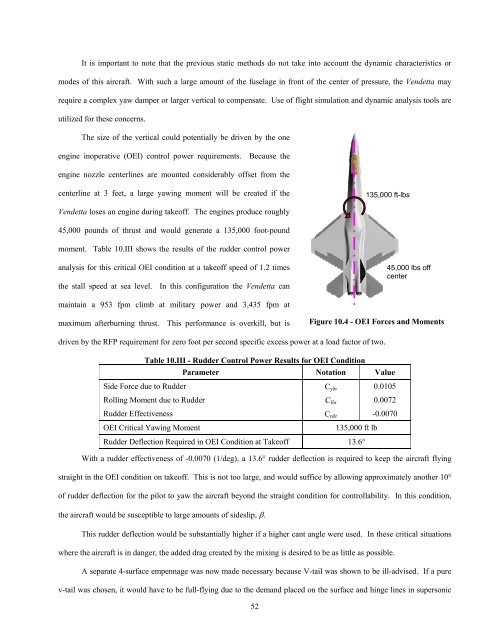Vendetta Final Proposal Part 2 - Cal Poly
Vendetta Final Proposal Part 2 - Cal Poly
Vendetta Final Proposal Part 2 - Cal Poly
You also want an ePaper? Increase the reach of your titles
YUMPU automatically turns print PDFs into web optimized ePapers that Google loves.
It is important to note that the previous static methods do not take into account the dynamic characteristics or<br />
modes of this aircraft. With such a large amount of the fuselage in front of the center of pressure, the <strong>Vendetta</strong> may<br />
require a complex yaw damper or larger vertical to compensate. Use of flight simulation and dynamic analysis tools are<br />
utilized for these concerns.<br />
The size of the vertical could potentially be driven by the one<br />
engine inoperative (OEI) control power requirements. Because the<br />
engine nozzle centerlines are mounted considerably offset from the<br />
centerline at 3 feet, a large yawing moment will be created if the<br />
135,000 ft-lbs<br />
<strong>Vendetta</strong> loses an engine during takeoff. The engines produce roughly<br />
45,000 pounds of thrust and would generate a 135,000 foot-pound<br />
moment. Table 10.III shows the results of the rudder control power<br />
analysis for this critical OEI condition at a takeoff speed of 1.2 times<br />
the stall speed at sea level. In this configuration the <strong>Vendetta</strong> can<br />
45,000 lbs off<br />
center<br />
maintain a 953 fpm climb at military power and 3,435 fpm at<br />
maximum afterburning thrust. This performance is overkill, but is<br />
Figure 10.4 - OEI Forces and Moments<br />
driven by the RFP requirement for zero foot per second specific excess power at a load factor of two.<br />
Table 10.III - Rudder Control Power Results for OEI Condition<br />
Parameter Notation Value<br />
Side Force due to Rudder C yδr 0.0105<br />
Rolling Moment due to Rudder C lδr 0.0072<br />
Rudder Effectiveness C nδr -0.0070<br />
OEI Critical Yawing Moment<br />
135,000 ft lb<br />
Rudder Deflection Required in OEI Condition at Takeoff 13.6°<br />
With a rudder effectiveness of -0.0070 (1/deg), a 13.6° rudder deflection is required to keep the aircraft flying<br />
straight in the OEI condition on takeoff. This is not too large, and would suffice by allowing approximately another 10°<br />
of rudder deflection for the pilot to yaw the aircraft beyond the straight condition for controllability. In this condition,<br />
the aircraft would be susceptible to large amounts of sideslip, β.<br />
This rudder deflection would be substantially higher if a higher cant angle were used. In these critical situations<br />
where the aircraft is in danger, the added drag created by the mixing is desired to be as little as possible.<br />
A separate 4-surface empennage was now made necessary because V-tail was shown to be ill-advised. If a pure<br />
v-tail was chosen, it would have to be full-flying due to the demand placed on the surface and hinge lines in supersonic<br />
52













